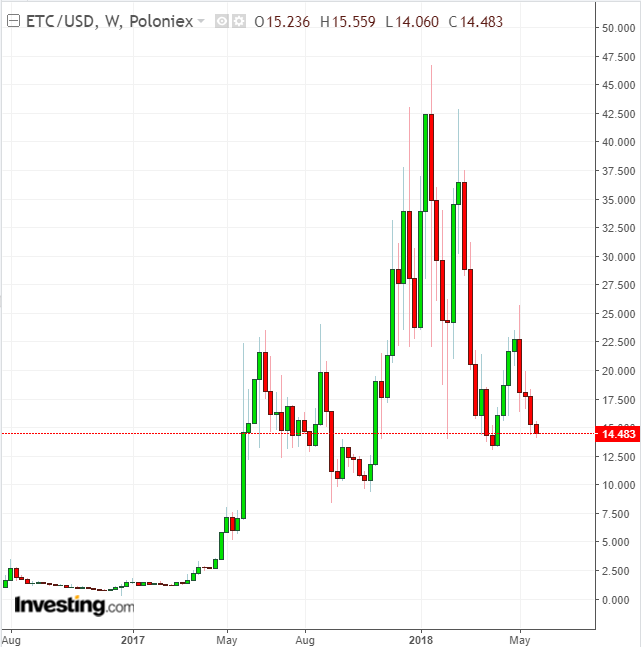Ethereum Classic (ETC) is set to hard fork some time today, Tuesday, May 29. But rather than create a 'sister' currency to this offshoot of the original Ethereum (ETH) platform, today's fork will remove the 'difficulty bomb' from the Ethereum Classic Mainnet at block 5,900,000, which developers say should solve issues related to mining profitability which could otherwise diminish future rewards for miners of the cryptocurrency.
What's a Difficulty Bomb and Why Was It Ever Inserted?
By removing the code responsible for the 'difficulty bomb' as it's popularly known, explains Alexey Bashlykov, chief technology officer at Zerion, the ETC network's developers are extracting an algorithm that makes mining of each successive block beyond 5,900,000 more challenging. Moreover, it's a feature that would have exponentially increased the rigor of mining each successive block to such a degree that ultimately mining for profitability would have become pointless.
The feature had been added by the original Ethereum developers, who planned to eventually switch from a Proof of Work (POW) protocol, to Proof of Stake (POS) concept. The 'difficulty bomb' was meant to be the trigger for this change.
Bashlykov points out that Ethereum is following through with this intention. The cryptocurrency's developers are going to switch to Casper, a POS protocol that makes it more difficult for malicious mining to occur.
Developers of Ethereum Classic, however, have chosen another way says Bashlykov. They decided to diffuse the 'difficulty bomb' and stick to Proof of Work—at least for now.
What motivated this decision to hard fork? Bashlykov believes ETC's developers don't trust alternative consensus algorithms (such as POS) while in their view POW works well. Of course, there's no general consensus on this point within the alt-currency universe and indeed many (including ETH's developers) agree that it's already been proven that POW isn't perfect either.
In Bashlykov's view, sticking with the POW protocol makes sense at this time.
"We're not talking about huge energy consumption, it is not even a Nash Equilibrium to always follow the protocol. Also, it lacks finalization, meaning you can never be certain about any state. But it works, and no one knows what unexpected issues a new consensus protocol may bring. For now, the Ethereum Classic community decided to be more conservative, which is quite well aligned with their initial vision. Right now, it is hard to say whether it is a right decision or not.”
Win-Win-Win
Are there technical factors behind the hard fork that investors should be aware of? Michal Zajda, lead architect at aeternity, the blockchain 3.0 platform, says there are two things that explain today's event.
The first, at the 5,900,000 block, is the technical fix that will rectify and alleviate next level mining difficulties. The second element of this hard fork is more ideological, having to do with stake-holder consensus points out Zajda. It sees Ethereum Classic once again emphasize its conservative philosophy by sticking to the POW consensus algorithm.
“The consensus is the very heart of every blockchain and more often than not, it defines the nature of a given cryptocurrency. While Proof-of-Work algorithms are simple energy for influence swaps, the Proof-of-Stake solutions may demonstrate more complex coupling.”
Sonia Miles-Khan, co-founder and COO of Watermelon Block, an app powered by blockchain technology, concurs that the new fork is designed to remove an existing mining limitation. But she points out that it's really nothing unusual:
“Such forks are common in open source blockchains and this is not the first that an Ethereum-based blockchain has seen. When it comes to ways of monitoring the health of a blockchain, various ‘proof of’ methods are [usually] used.”
Other sources highlight that miners are the backbone of digital currency PoW eco-systems, especially for ETC. They play an essential role in ETC's birth and growth. Removing the “difficulty bomb” will pave the way for the alt-currency's roadmap to expand, thereby reflecting miner, investor and the ETC community’s interest.
In other words a potential win-win-win for all concerned. And likely welcome in the face of the currency's recent plunge.

Ironically for both Ethereum and Ethereum Classic, Matt Engel, community leader, Achain Global, notes that both currencies have become central to the issue of scalability and the debate about next steps toward correction.
“With last year’s Crypto Kitty debacle, one single dapp managed to clog the entire Ethereum network so significantly that it degraded its usability. So, with this challenge, and now a real-life example of how disruptive it can be, the issue of scalability in blockchain has come to the fore.”
